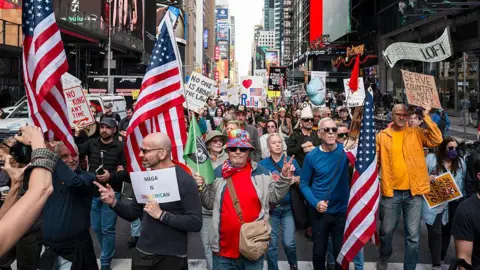This weekend's No Kings demonstrations drew an estimated crowd of millions across the US to protest President Donald Trump's policies and his willingness to push the boundaries of presidential authority.
It was a moment for likeminded Democrats, liberals and some anti-Trump Republicans to rally together at a time when the American left has little formal power in national politics.
But where do they go from here?
By most accounts, the turnout at Saturday's events - in major US cities like Chicago, New York, Washington and Los Angeles, as well as hundreds of smaller towns – was higher than expected and surpassed the first No Kings rally in June.
Congressional Republicans had warned that the demonstrations would be anti-American, and some conservative governors had put their law enforcement and National Guard on alert in case of violence.
The massive rallies turned out to be peaceful – a carnival, not carnage. In New York City, there were no protest-related arrests, and the gathering in Washington DC featured families and young children.

Today all across America in numbers that may eclipse any day of protest in our nation's history, Americans are saying loudly and proudly that we are a free people, we are not a people that can be ruled, our government is not for sale, Senator Chris Murphy of Connecticut said in his speech to the Washington DC rally.
Just down the street from the No Kings gathering in the nation's capital, the White House responded to the protests with derision.
Who cares, deputy press secretary Abigail Jackson wrote in response to multiple media inquiries about the marches.
Trump shared several AI-generated videos on his Truth Social website of him wearing a crown, including one where he was flying a jet that dumped what appeared to be human waste on the protesters.
While Republicans may be downplaying the significance of the marches, the scale of the turnout – along with Trump's net negative approval rating in major opinion polls - hints at a Democratic opportunity to rebound from last year's electoral defeats.
The party still has a long way to go, however.
Polls suggest only a third of Americans view it favourably - the lowest for decades - and Democrats are divided over how to mount an effective opposition to Trump when they no longer control either chamber of Congress.
Liberals took to the streets on Saturday for a variety of reasons. Trump's aggressive immigration enforcement, his tariff policies, his government cuts, his foreign policy, his deployment of National Guard in US cities and his norm-breaking use of presidential authority were all frequent topics of concern and outrage.
Some of the frustration was also directed at Democratic leaders.
The Democrats have been more combative over the ongoing government shutdown, which is about to enter its fourth week. They have been unwilling to approve a short-term extension of current federal spending without a bipartisan agreement to address health-insurance subsidies for low-income Americans set to expire at the end of the year.
Because of Senate parliamentary rules, Democrats have some power despite being in the minority – and, at least so far, the public seems to be assigning at least as much, if not more, blame for the impasse to Trump and the Republican majority.
The reality is that Democratic leaders in the Senate will ultimately have to find a way out of the crisis. But they may be hard-pressed to reach terms that the protesters who took to the streets on Saturday will find acceptable.
These upcoming elections, particularly in battleground states, could provide critical insight into whether the anti-Trump sentiment on display during the No Kings protests translates into electoral success for Democrats.




















